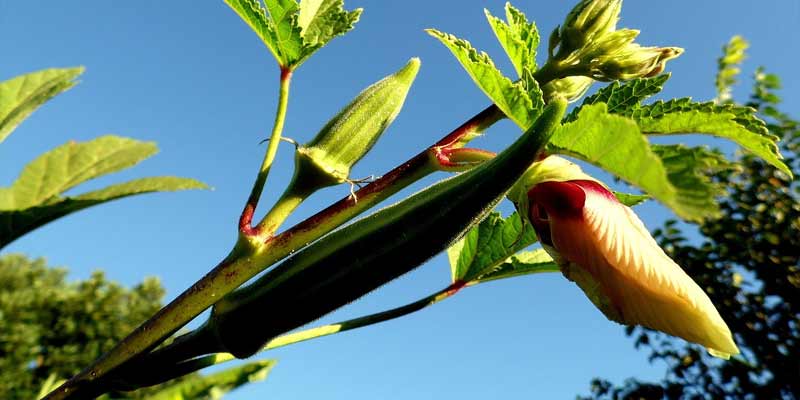The heat-loving, nutritious, and versatile okra, a staple in many gardens – its unique flavor is unmatched. To cultivate an abundant crop of thriving okra; however, one must consider several factors during planting time: soil temperature, sensitivity to frost, and the duration of the growing season are crucial elements.
Our comprehensive guide will delve into this topic deeply—exploring not only optimal timing. .for planting but also conditions indispensable for successful growth along with expert tips that guarantee a bountiful harvest from this beloved summer vegetable.
Understanding Okra
Scientifically identified as Abelmoschus esculentus, Okra – a member of the mallow family – boasts distinctively green pods. Abundant in fiber, vitamins, and antioxidants; it not only enriches your diet with nutrition but also contributes versatility to an array of culinary dishes.
Thriving in temperatures exceeding 50°F (10°C) due to its warm-season nature; Okra necessitates a growing season free from frost for optimal growth.
3 Factors Influencing Planting Time
1. Frost Sensitivity
Frost highly sensitizes okra, and its seeds refuse to germinate in cold soil. Therefore, one must plant okra after the final frost date in their specific region for successful germination and growth. By waiting until the soil warms adequately—this action minimizes the risk of damaging young okra plants.
2. Soil Temperature
Warm soil, ideally within a temperature range of 75°F to 90°F (24°C to 32°C), is essential for the germination of okra seeds. When you plant your okra in soil that consistently maintains a temperature higher than 60°F (15°C), it encourages faster and more uniform sprouting.
3. Growing Season Duration
Typically, the growing season for okra spans a relatively long duration of around 50 to 65 days from planting to harvest. To plan your okra planting effectively and thus optimize its potential harvest, you must understand and consider this localized length of growth period; indeed, it is key in ensuring ample time for productive plant production.
Ideal Planting Time
Late Spring to Early Summer
Late spring to early summer, after the passing of the last frost date in most regions, presents optimal timing for planting okra. This strategy leverages adequate soil warmth that facilitates successful germination.
Moreover, it guarantees a generous duration—before concluding with an efficient growing season—for growth and pod production by your precious Okra plants.
Soil Preparation
Incorporate well-rotted compost or organic matter in advance to prepare the soil. Well-draining soil with a pH level between slightly acidic and neutral (6.0 – 7.0) is ideal for thriving okra plants.
Consider conducting a soil test; it will assist you in evaluating and modifying the pH of your soil, if necessary.
Plant Spacing and Sunlight
Plant your space okra by arranging them in rows, ensuring a distance of 12 to 18 inches between each plant – maintain gaps of 3-4 feet for the rows. Optimal growth demands full sunlight; therefore, select a location for planting that basks under at least eight hours of direct sun each day.
Optimizing Growth Conditions
Watering
Consistently moist soil, particularly during the germination and early growth stages, is a preference for okra plants. Deeply water the okra when you find the soil to be dry upon touch.
Furthermore, mulching around them not only aids in retaining soil moisture but also suppresses weeds with effectiveness.
Fertilization
Incorporate a general-purpose fertilizer into the soil before planting Okra, as it benefits from balanced fertilization due to being a moderately heavy feeder. If necessary during the growing season, provide supplementary fertilization.
However, be cautious of excessive nitrogen; this can trigger abundant foliage growth but suppress pod production in turn.
Support for Tall Varieties
Tall growth, often exceeding 6 feet, characterizes certain varieties of okra. To mitigate potential damage from their weighty pods and prevent bending or breaking under this load, supporting these taller types with stakes or cages is advisable.
Harvesting Okra
Essential to ensuring tender and flavorful pods is the knowledge of when to harvest okra. Typically, about two months after planting, one can start harvesting okra pods that measure 2-4 inches in length. Regular harvesting further stimulates pod production by the plant.
3 Expert Tips for Okra Planting
1. Successive Planting
Consider implementing successive planting to prolong your summer okra harvest by sowing the seeds at intervals of 2-3 weeks, strategically staggering the plantation times.
By adopting this method—a guarantee for an uninterrupted supply of fresh okra—you circumvent a scenario where abundance is limited to one instance.
2. Heat-Loving Crop
Hot weather promotes the thriving of okra, while its growth may suffer in cooler conditions. Should you encounter lower temperatures, employing black plastic mulch could warm the soil and create an advantageous environment for your okra plants.
3. Harvest Promptly
Ensure the tenderness of okra pods and prevent them from toughening by promptly harvesting. During the peak harvest period, inspect your plants every 2 to 3 days; then, use a sharp knife or scissors to cut off each pod at its base.
Conclusion
Optimizing conditions for robust okra plants and a plentiful harvest hinges significantly upon planting the crop at precisely its opportune time. Factors such as frost sensitivity, soil temperature variations, and duration of the growing season all warrant careful consideration in this regard.
Ensuring an enriching addition to your garden—teeming with flavorfulness—is guaranteed when you sow those first-rate okra seeds at just the right moment; it matters not whether one is a seasoned enthusiast or merely taking their initial steps into gardening territory: timing truly makes all difference here. Happy planting!



